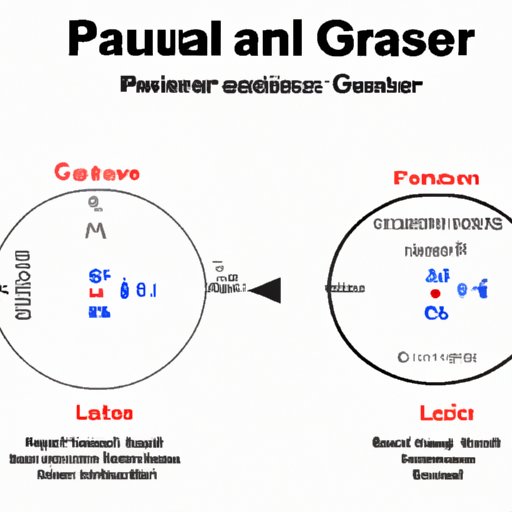
I. Introduction
When working with gases, it is crucial to understand the concept of partial pressure. It is a term that describes the pressure exerted by a single gas in a mixture of gases. It plays a significant role in many fields such as chemistry, physics, and engineering. In this article, we will explore the concept of partial pressure, its calculation, and its importance in everyday life.
II. Understanding the concept of partial pressure
Partial pressure is defined as the pressure exerted by an individual gas in a mixture of gases. According to Dalton’s law of partial pressures, the pressure of a gas mixture is equal to the sum of the pressures of each gas in the mixture.
To calculate the partial pressure of a gas in a mixture, we need to know its mole fraction, which is the ratio of the number of moles of that gas to the total number of moles in the mixture.
III. The Process of Calculating Partial Pressure Made Simple: Step-by-Step Guide
The process of calculating partial pressure involves the following steps:
A. Identifying the gases present
To calculate the partial pressure of a gas, we first need to know which gas(es) are present in the mixture and their respective mole fractions.
B. Determining the total pressure
We also need to know the total pressure of the mixture, which can be obtained by using a barometer or a manometer.
C. Calculation of partial pressure of each gas
To calculate the partial pressure of a gas in the mixture, we use the formula:
Partial pressure = Mole fraction x Total pressure
D. Examples of partial pressure calculation
Let’s take an example of a gas mixture containing oxygen and nitrogen. Suppose the mole fraction of oxygen in the mixture is 0.2, and the total pressure is 1 atm. To calculate the partial pressure of oxygen, we use the formula:
Partial pressure of oxygen = 0.2 x 1 atm = 0.2 atm
Similarly, the partial pressure of nitrogen can be calculated using its mole fraction and the total pressure.
IV. Mastering Partial Pressure Calculation: Tips and Tricks
A. Understanding units and conversions
When working with partial pressures, it is essential to use consistent units for pressure, volume, temperature, and moles. You may need to convert the units to ensure that they match before performing the calculation.
B. Applying the ideal gas law
The ideal gas law relates the pressure, volume, temperature, and the number of moles of a gas. By using this law in combination with Dalton’s law of partial pressures, we can calculate the partial pressure of each gas in a mixture.
C. Common mistakes to avoid
Some common mistakes to avoid when calculating partial pressure include forgetting to convert units, using the wrong mole fraction, and not accounting for the gas constant. We can avoid these mistakes by carefully following the steps and double-checking our calculations.
V. Partial Pressure Calculation: A Comprehensive Guide for Beginners
If you’re new to partial pressure calculations, it might seem intimidating at first. However, with practice and a solid understanding of the basic concepts, anyone can master this skill.
Beginners can start by understanding the definition of partial pressure and familiarizing themselves with the formula for its calculation. They can then work on solving examples and practice problems to gain confidence in the technique.
VI. Solving the Mystery of Partial Pressure: A Guide for Chemistry Students
A. Importance of understanding partial pressure in chemistry
Partial pressure plays a crucial role in many chemical reactions and processes. For example, the partial pressure of a gas can affect its solubility in a liquid and the rate of its reaction with other compounds.
B. Step-by-step instructions for partial pressure calculations
Chemistry students can benefit from a detailed, step-by-step guide to partial pressure calculation. This guide should cover the basic concepts, formula, and examples to help students apply their knowledge in real-life situations.
C. Applications of partial pressure in chemistry
Partial pressure is used in various fields of chemistry, such as biochemistry, environmental chemistry, and analytical chemistry. In biochemistry, for example, the partial pressure of oxygen in blood is critical in determining the efficiency of gas exchange in the lungs.
VII. Partial Pressure: An Explainer on Calculation and Application
A. Understanding partial pressure and its role in various fields
Partial pressure is not just limited to chemistry. It also plays a significant role in physics, engineering, and meteorology. Understanding partial pressure is essential for designing and analyzing air conditioning systems, predicting weather patterns, and studying the atmosphere of other planets.
B. Different methods of calculating partial pressure
There are various methods of calculating partial pressure, depending on the type of gas mixture and the available data. One can use the ideal gas law, Raoult’s law, and Henry’s law, among others, to calculate partial pressure accurately.
C. Applications and examples in various fields
Partial pressure can be applied in many fields, such as medicine, aviation, and scuba diving. In medical settings, monitoring the partial pressure of various gases in the blood is crucial for diagnosing and treating respiratory disorders. In aviation and scuba diving, understanding partial pressure is crucial for avoiding the risks associated with different atmospheric pressures at high altitudes or underwater.
VIII. Conclusion
Partial pressure plays a crucial role in many fields, and understanding its calculation is essential for anyone working with gases. This article has provided a comprehensive guide to partial pressure, including its definition, calculation, and applications. We hope that readers can use this guide to master the skill of partial pressure calculation and apply it to real-life situations in their respective fields.
Remember, whether you’re a chemistry student, a scientist, or an engineer, understanding partial pressure can help you achieve better results in your work.
Additional resources for learning more about partial pressure calculation include textbooks, online lectures, and tutorials. We encourage readers never to stop learning and to continually seek new knowledge in this fascinating field.





